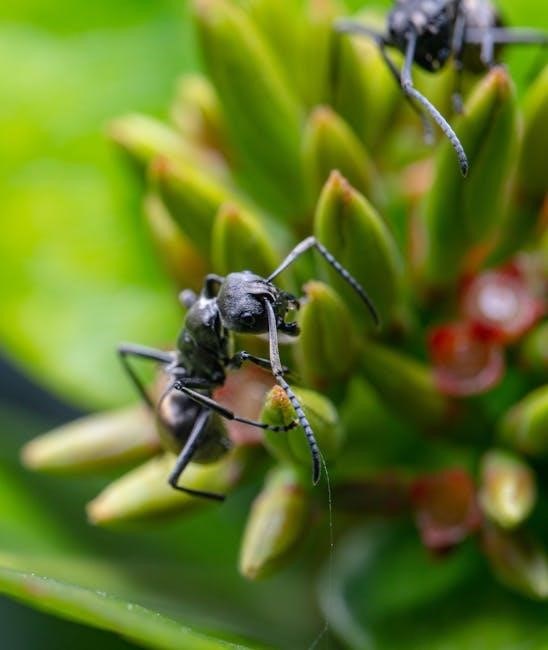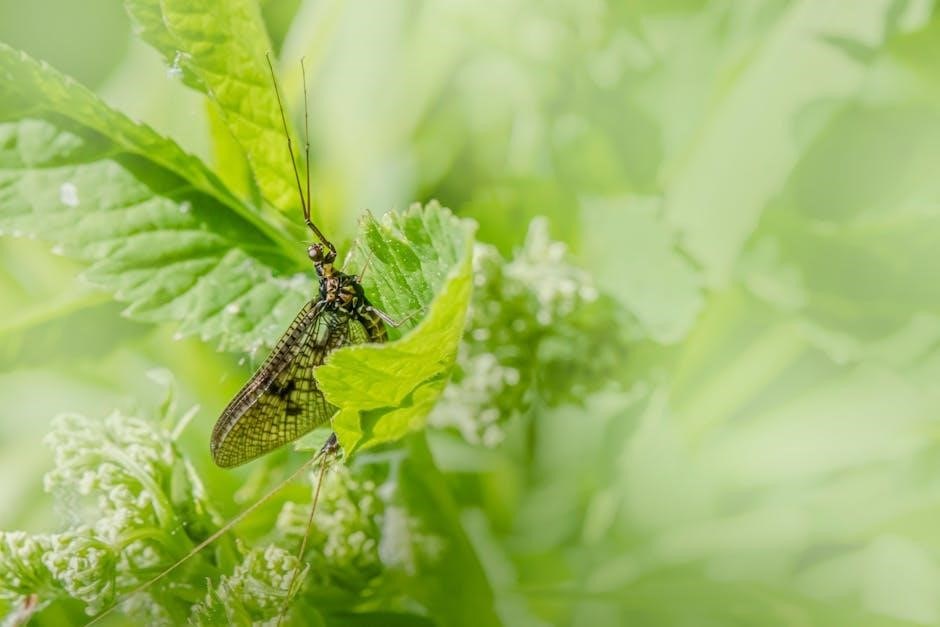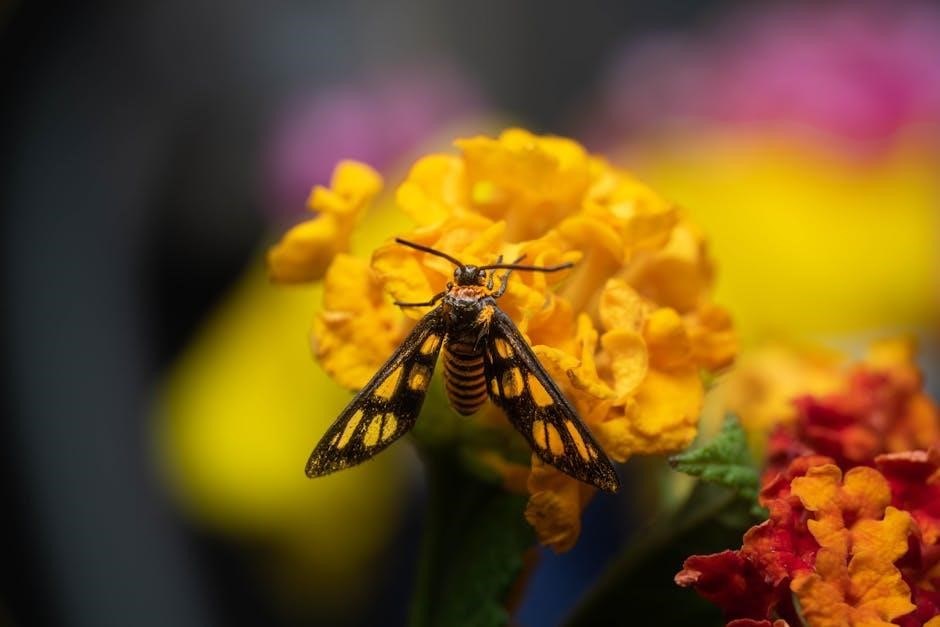Bug catching is a popular activity in Animal Crossing: New Leaf, offering a fun way to explore and collect various insects․ With a net, strategy, and patience, players can discover rare species and enjoy the relaxing gameplay․
How Many Bugs Are There in Animal Crossing: New Leaf?
In Animal Crossing: New Leaf, there are a total of 72 bugs that players can collect․ This number includes all insects that can be found in the game, each with unique characteristics, habitats, and times they appear․ Some bugs are new to the series, adding variety to the collection process․
Bugs on Tortimer Island are available year-round, regardless of the season, making it a great place to catch rare species․ The in-game encyclopedia keeps track of all discovered bugs, encouraging players to complete their collection and learn about each species․
When and Where to Find Bugs
Bugs in Animal Crossing: New Leaf are found in diverse locations like trees, ground, water, and Tortimer Island, with availability varying by time and season․
Best Times to Catch Bugs
The ideal times for bug catching vary by species, with many active during specific hours․ Emperor Butterflies fly from 8 PM to 7 AM, while Fireflies appear near rivers at night․ Evening Cicadas emerge between 4 PM and 7 PM․ Some bugs, like the Dung Beetle, are most active in the late evening and early morning․ Timing your bug-hunting trips according to these schedules increases your chances of success․ Additionally, Tortimer Island offers year-round bug availability due to its perpetual summer setting, making it a great spot for catching rare species anytime․
Common Bug Locations
Bugs in Animal Crossing: New Leaf can be found in various locations throughout your town․ Many insects are discovered on trees, such as beetles and cicadas, while others, like ants and ground beetles, are found crawling on the ground․ Water-based bugs, such as pond skaters, are often near ponds or rivers․ Flowers attract butterflies and bees, making them great spots for catching pollinators․ Some bugs, like the Dung Beetle, are active at night and can be found on the ground under streetlights․ Explore different areas, including beaches and Tortimer Island, to discover a wide variety of species․
Bugs on Trees
Many bugs in Animal Crossing: New Leaf can be found on trees, including beetles, cicadas, and butterflies․ Approach trees slowly with your net to avoid scaring them off․ Cicadas are often heard buzzing loudly during the day, while beetles may appear at night․ Certain species, like the Emperor Butterfly, are drawn to flowers near trees․ To catch tree bugs, hold your net and press A when close․ Timing and stealth are key to capturing these elusive insects․ Tree-based bugs add diversity to your collection and offer unique challenges for players․
Bugs on the Ground
Bugs on the ground in Animal Crossing: New Leaf include pill bugs, centipedes, and dung beetles․ These insects are often found crawling on grass, dirt paths, or near flowers․ Pill bugs are common and can be spotted during the evening, while centipedes appear at night․ Dung beetles, though rare, can be found near snowballs during winter․ To catch them, approach quietly with your net and swing when close․ Ground bugs add variety to your collection and can be sold for a decent number of bells, especially the rarer species like the dung beetle․
Bugs Near Water
Near water, you can find a variety of bugs like dragonflies, damselflies, and water striders․ Dragonflies often hover over ponds during the day, while damselflies are seen near slow-moving streams․ Water striders skate on the surface of water, making them tricky to catch․ To increase your chances, approach quietly with your net and swing when they land․ These aquatic insects add a unique touch to your collection and can be sold for a good price, especially the rarer dragonfly species․
How to Catch Bugs
Catching bugs in Animal Crossing: New Leaf requires patience and the right technique․ Use your bug net effectively, move quietly, and strike at the perfect moment for success․
Using the Bug Net
To catch bugs, you’ll need a bug net, purchasable from Nookling Junction for 500 Bells․ Equip the net, approach bugs slowly, and press A to swing․ For flying insects, aim carefully․ Bugs on trees require precise timing․ Hold A to sneak up, then release to catch․ Practice makes perfect for rare species like the Emperor Butterfly or Firefly, active at night․ Patience and steady movement are key to success in your bug-catching adventures․
Sneaking Up on Bugs
Sneaking is essential for catching bugs without startling them․ Hold the A button to move slowly while the net is equipped․ Approach bugs quietly, especially rare ones like the Emperor Butterfly or Firefly․ For tree-dwelling bugs, stand directly in front and creep forward until your character is halfway up the tree․ Release A to swing the net․ Patience is key, as sudden movements will scare them away․ Mastering this technique will help you catch even the most elusive insects in Animal Crossing: New Leaf․
Tips for Catching Rare Bugs
To catch rare bugs like the Emperor Butterfly or Firefly, timing and location are critical․ Visit areas with flowering plants or water at specific times, such as dusk or dawn, when rare insects are most active․ Use the sneak technique to approach quietly, and avoid sudden movements․ Visiting Tortimer Island is highly recommended, as it offers year-round access to rare bugs․ Planting flowers and trees can also attract rare species․ Persistence and patience are key to completing your bug collection in Animal Crossing: New Leaf․
Bugs Available on Tortimer Island
Tortimer Island in Animal Crossing: New Leaf is a unique location where 28 of the total 72 bugs can be caught year-round․ This includes rare species like the Emperor Butterfly, Firefly, and Giant Cicada․ The island’s perpetual summer season ensures that bugs typically found during warm weather are always available․ Some bugs, like the Wharf Roach, are exclusive to the island․ Visiting Tortimer Island is a great way to collect rare insects without worrying about seasonal limitations, making it a must-visit destination for serious bug enthusiasts․
Rare and Valuable Bugs
Rare bugs like the Emperor Butterfly, Dung Beetle, Firefly, and Evening Cicada are highly valuable and challenging to find․ Their unique times and locations make them sought-after catches․
Emperor Butterfly
The Emperor Butterfly is one of the rarest and most valuable bugs in Animal Crossing: New Leaf, selling for 2,500 Bells․ It appears while flying near flowers in your town between 8 PM and 7 AM․ This nocturnal butterfly is challenging to catch due to its elusive nature and limited active hours․ Players must approach slowly with a net to avoid scaring it away․ Its high value makes it a prized catch for collectors aiming to complete their museum collection or maximize their Bell earnings through selling․
Dung Beetle
The Dung Beetle is a unique and valuable bug in Animal Crossing: New Leaf, selling for 800 Bells․ Active from 5 PM to 8 AM, it’s often found rolling snowballs, making it a distinctive sight․ This bug’s behavior sets it apart, as it interacts with its environment in a unique way․ Players should approach quietly with a net to catch it effectively․ The Dung Beetle’s rarity and intriguing actions make it a sought-after addition to any collection or museum donation․
Firefly
The Firefly is a glowing insect in Animal Crossing: New Leaf, often found near water sources at night․ Active from 7 PM to 4 AM, it lights up the evening with its bioluminescence․ Selling for 300 Bells, the Firefly is a common but beautiful catch․ To increase chances of spotting one, focus on areas near rivers or ponds during its active hours․ Its gentle glow makes it easy to locate, but approach slowly to avoid scaring it away․ A great addition to any collection, the Firefly adds charm to your bug-hunting journey․
Evening Cicada
The Evening Cicada is a common insect in Animal Crossing: New Leaf, found on trees between 4 PM and 7 PM․ It sells for 550 Bells, making it a modest but consistent catch․ Known for its distinctive buzzing sound, the Evening Cicada is easy to locate during its active hours․ Approach slowly with your net to avoid startling it․ While not rare, it’s a great early addition to your bug collection, offering a straightforward catching experience for new players․
Seasonal Bugs Guide
Bugs in Animal Crossing: New Leaf appear during specific seasons, offering variety throughout the year․ Each season introduces unique species, making it essential to track their availability monthly to complete your collection․
Bugs Available in Spring
In Animal Crossing: New Leaf, spring brings a variety of bugs to catch, including the Emperor Butterfly, Firefly, and Evening Cicada․ These species emerge during warmer months, often near flowers or water․ The Emperor Butterfly can be spotted flying around blossoms, while Fireflies appear near rivers at dusk․ Evening Cicadas cling to trees and are active in the late afternoon․ Spring is a great time to diversify your collection, as many rare bugs like the Giant Cicada and Stinkbug also make their debut during this season․
Bugs Available in Summer
Summer in Animal Crossing: New Leaf is bustling with diverse bug species․ The Agrias Butterfly, Birdwing Butterfly, and Centipede are common during this season․ Fireflies and Evening Cicadas remain active, while rare bugs like the Giant Cicada and Dung Beetle appear․ Summer is ideal for catching vibrant species like the Emperor Butterfly and Tiger Beetle․ Tortimer Island is a hotspot for summer bugs, offering year-round access to species like the Hermit Crab and Wharf Roach․ This season is perfect for expanding your collection with colorful and elusive insects․
Bugs Available in Fall
Fall in Animal Crossing: New Leaf brings a variety of bugs, including the Ladybug, Red Dragonfly, and Stinkbug․ The season also sees the appearance of nocturnal bugs like the Tarantula and Scorpion․ These species are often found on trees or near flowers during warmer evenings․ Fall is a great time to catch bugs like the Centipede and Pill Bug, which are active during the day․ Use your net wisely and explore thoroughly to collect these autumnal insects and complete your seasonal collection․
Bugs Available in Winter
Winter in Animal Crossing: New Leaf offers a unique set of bugs, including the Dung Beetle, Snow Crab, and Winter Cicada․ These species are active during colder months and can be found in specific locations like snow-covered areas or near water․ The Dung Beetle is most active from 5 PM to 8 AM, while the Winter Cicada appears in the evening․ Some winter bugs, like the Snow Crab, can be found by hitting snowballs․ Winter provides a chance to catch rare and valuable insects, making it a great season to enhance your collection or sell for bells;

How to Sell Bugs for Bells
To sell bugs, visit Timmy and Tommy’s store or Nook’s Cranny․ Bugs can be sold individually or in batches for bells, with rare species fetching higher prices․
Best Prices for Bugs
Bug prices vary based on rarity and demand․ Rare species like the Emperor Butterfly sell for 2,500 bells, while common bugs like the Firefly fetch 300 bells․ High-value bugs include the Dung Beetle at 800 bells and the Evening Cicada at 550 bells․ Selling rare or seasonal bugs during their active times yields the highest profits․ Check prices at Nook’s Cranny or with Re-Tail to maximize earnings․ Catching rare bugs and avoiding common ones increases your overall bell revenue․
Where to Sell Bugs
Bugs can be sold to various vendors in Animal Crossing: New Leaf for bells․ Nook’s Cranny is the primary shop where bugs are sold, offering competitive prices․ The Re-Tail store, run by Reese, often provides higher prices for rare or seasonal bugs․ Additionally, special characters like C․J․ (during fishing tournaments) may buy bugs at premium rates․ Bugs can also be donated to the Museum for completion, though this doesn’t yield bells․ Selling bugs is a great way to earn bells and progress in the game․

Bugs in the Museum
Donating bugs to the museum in Animal Crossing: New Leaf allows players to display their collection․ Completing the bug set rewards players and pleases Blathers․
Donating Bugs to the Museum
Donating bugs to the museum in Animal Crossing: New Leaf is a great way to showcase your collection․ Each donation helps complete the museum’s bug encyclopedia․ Once a bug is donated, it is displayed in a case, and you can view it anytime․ Donating rare or new species often rewards you with exclusive comments from Blathers․ Additionally, filling the museum’s bug collection can unlock special rewards and improve your town’s rating․ Organizing your donations by season or rarity can also make it easier to track your progress․
Completing the Bug Collection
Completing the bug collection in Animal Crossing: New Leaf requires catching all 72 species․ Each bug has unique characteristics, making it a challenging yet rewarding task․ Rare and seasonal bugs add to the difficulty, as they appear only during specific times or under certain conditions․ Dedication and patience are key to filling your encyclopedia․
The museum’s bug section is unlocked after your first donation, and completing it grants a sense of accomplishment․ Rare bugs, like the Emperor Butterfly or Dung Beetle, are particularly sought after․ Catching every bug showcases your skill and dedication to the game, making it a memorable achievement for any player․

Bugs Guide: Tips and Tricks
Master bug catching with essential tips: use the right net, approach quietly, and time your catches perfectly․ Visit Tortimer Island for rare species and enhance your collection․
How to Farm Rare Bugs
To farm rare bugs effectively, consider chopping down trees to reduce cicada spawns, encouraging rarer species to appear․ Visit Tortimer Island, where summer conditions persist year-round, offering unique bug opportunities․ Use the right net and approach quietly to avoid scaring them off․ Time your visits during peak bug hours, such as early morning or late evening, and maintain a well-groomed island to attract rare insects․ Patience and persistence are key to farming rare bugs successfully in Animal Crossing: New Leaf․
Organizing Your Bug Collection
Organizing your bug collection in Animal Crossing: New Leaf is essential for tracking progress and showcasing your achievements․ Use the in-game encyclopedia to catalog each bug, complete with details like time, location, and price․ Donate rare bugs to the museum to earn completion badges and display your favorites in exhibits․ Regularly check your collection to ensure accuracy and completeness․ This system helps you identify missing species and plan your next bug-catching adventure, making the process both efficient and enjoyable․

Common Mistakes to Avoid
When catching bugs in Animal Crossing: New Leaf, avoid common errors like moving too quickly, which scares bugs away․ Ensure you use a net, as other tools won’t work․ Timing is key—miss rare bugs by ignoring specific hours or seasons․ Overlooking Tortimer Island’s year-round summer bugs is another mistake․ Don’t forget to check your encyclopedia regularly to track progress and avoid missing species․ Lastly, avoid neglecting the museum, as donating bugs completes your collection and unlocks rewards․ These mistakes can hinder your bug-catching success, so stay attentive and patient․
New Bugs Introduced in Animal Crossing: New Leaf
Animal Crossing: New Leaf introduced several new bugs to the series, including the Rice Grasshopper, Giant Cicada, Cicada Shell, Stinkbug, Tiger Beetle, Hermit Crab, Wharf Roach, and House Centipede․ These additions expanded the diversity of insects, offering fresh challenges and opportunities for players․ Each new bug has unique characteristics, such as specific times, locations, and seasons for catching․ These introductions enhanced the game’s realism and depth, making bug catching even more engaging and rewarding for enthusiasts․
Updates and New Bug Information
Animal Crossing: New Leaf has seen updates and new bug information over time, enhancing the player’s experience․ New bugs like the Rice Grasshopper and Giant Cicada were introduced, offering unique catching challenges․ Updates have provided clarity on bug locations, times, and seasons, while community contributions and guides have made bug catching more accessible․ These updates ensure the game remains dynamic, with fresh discoveries and strategies for players to enjoy․ Staying informed about the latest bug data helps enthusiasts maximize their collections and achievements․
Bug catching in Animal Crossing: New Leaf is a delightful adventure with 72 species to discover․ From common insects to rare finds, this activity offers endless fun and learning․ Players enjoy the thrill of the hunt, the strategy of sneaking up, and the satisfaction of completing their collection․ Whether you’re a seasoned pro or a new player, bug catching provides hours of engaging gameplay․ Keep exploring, stay patient, and happy hunting—every bug brings you closer to your goals!
Additional Resources
For more detailed insights, check out the Animal Crossing: New Leaf Wiki, which provides comprehensive lists of bugs, their prices, and locations․ YouTube channels like Abdallah offer video guides and tips for catching rare bugs․ Additionally, online forums and communities, such as Reddit, share strategies and real-time updates․ These resources complement your journey, helping you master bug catching and complete your collection efficiently․ Happy gaming!